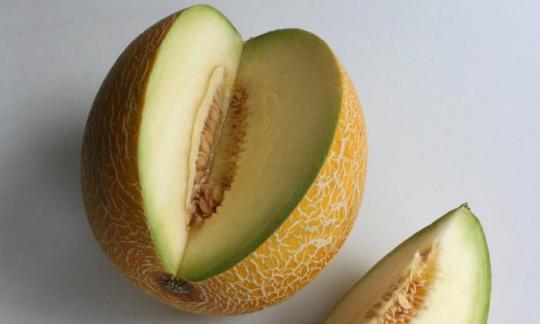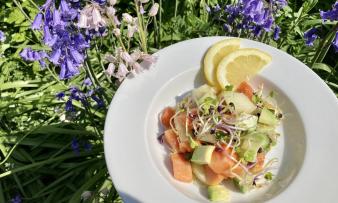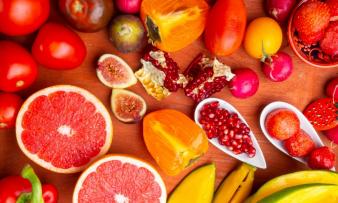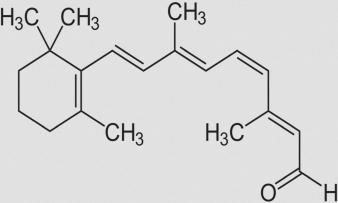Table of contents
Use in the kitchen
Galia melons have a slightly net-like, yellowish, non-grooved skin. Therefore, they are usually classified as reticulated melons. Their botanical name is Cucumis melo var. reticulatus or cantalupensis.
The flesh is white to slightly green and tastes very sweet. In terms of aroma and taste, the Galia resembles the "Ogen type" of the Cantaloupe group 20 (more on this in the chapter Further information) and is reminiscent of mango and kiwi.
Sugar melons such as the Galia melon, the cantaloupe melon or the honeydew melon are generally popular as dessert melons or raw finger foods because the raw flesh provides a sweet and juicy refreshment.
With Galia melon pieces you can easily prepare a delicious vegan snack or aperitif. Galia melons also taste great chopped up in muesli, fruit salad or punch. Pureed with lemon juice, mint leaves and mineral water you can create a refreshing summer drink.
For a grilled dessert, you can brush melon pieces with a little rapeseed oil and lemon juice and grill them on both sides for about 5-10 minutes.
Boiled melon juice, i.e. syrup, is ideal for sweetening and flavoring vegan creams. Galia melons can also be used to make delicious vegan sorbets, cocktails, smoothies and raw shakes. Vegan melon lassi can be made with vegan yogurt ( soy yogurt) and a plant-based drink (e.g. oat milk). The internet also provides recipes for vegan melon cakes. This is a good way to use floury-tasting Galia melons.
Galia melons also go well in savory dishes, e.g. in a hearty salad: with avocados, vegan feta made from tofu (can also be made from almonds or cashews), quinoa (or buckwheat, bulgur, couscous etc.) and lemon juice ( lime juice), salt andpepper, you can have a great dish on the table in no time. Seeds or nuts such as walnuts, pine nuts orpumpkin seeds and fresh mint leaves refine the salad.
In raw food cuisine, it is definitely worth trying a gazpacho (cold soup) with raw Galia melon (or cantaloupe melon). Here, the sweet melon flavor meets sour vegetables such as raw cucumbers or tomatoes and hot spices such as chili and pepper. For a vegan carpaccio, you can also use a Galia melon (instead of the honeydew melon suggested in the recipe link) and refine it with rocket.
Vegan recipe for a refreshing Galia melon drink
Ingredients (for 2 people): 1 Galia melon (organic), 150 ml drinking water, 150 g ice cubes, juice of one lime, 1 pinch of sea salt, 1/2 tbsp chia seeds, ice cubes.
Preparation: Put all ingredients except the chia seeds and the extra ice cubes into a high-speed blender and puree until smooth. Stir in the chia seeds and leave to swell in the fridge for 10 minutes. Add ice cubes and serve the vegan drink immediately.
Vegan recipes with Galia melon (raw) can be found under the note: " Recipes that have the most of this ingredient ".
| Not only vegans or vegetarians should read this: Vegans often eat unhealthily. Avoidable nutritional errors. |
Purchasing - Storage
Galia melons can be found in the large supermarket chains such as Coop, Migros, Denner, Volg, Spar, Aldi, Lidl, Rewe, Billa, Edeka or Hofer, often in controlled organic quality (organic quality). This variety can often be bought in organic supermarkets such as Denn's Biomarkt or Alnatura as well as seasonally at the weekly market. Galia melons are in Central Europe from Available in stores from May to August (depending on the size of the supermarket and the region, availability begins in March or lasts until September); regional products have their peak season between July and September. 25
When is a Galia melon ripe? Ripe Galia melons can be recognized by the fleeting musky scent that the fruit can release. 4,21 The skin of ripe fruit is yellow in color (sometimes with a few green spots), which often turns orange - with the exception of a few varieties whose skin remains green even when ripe. 21 Inside, you will find white-greenish flesh.
The availability of Galia melons varies depending on the size of the store, catchment area, etc. Our recorded food prices for the DA-CH countries can be found above under the ingredient image - and by clicking you can see their development at various suppliers .
Storage tips
Ripe, whole Galia melons do not last very long, 6 especially at room temperature. After harvesting, they can be kept cool and dry for between one and three weeks. 4,9 Cut melons should be stored in the refrigerator and eaten within a few days, as they spoil quickly. 9
The flesh of melons is low in acid and provides a good breeding ground for harmful microorganisms such as salmonella, listeria or EHEC. The pathogens get onto the flesh either when the (unwashed) peel is cut open or via contaminated hands or kitchen utensils (knife, cutting board). Good kitchen hygiene is important to prevent infections. Pre-cut melon pieces should be eaten quickly or refrigerated. If stored unrefrigerated for several hours, the Federal Institute for Risk Assessment ( BfR) recommends that the melons be thrown away. 10
Ingredients - Nutritional values - Calories
A raw Galia melon has few calories per 100 g, namely 56 kcal. The carbohydrate content is 13 g/100g, of which 12 g are sugar. With 0.08 g fat and 0.88 g protein per 100 g, the Galia melon is almost fat-free and very low in protein. The 0.73 g fiber covers 2.9% of the daily requirement.
A raw Galia melon contains 33 mg of vitamin C per 100 g, which is 41% of the daily requirement. Mangos (36 mg/100 g) andblack elderberries (36 mg/100 g) have comparable amounts. 8 The vitamin C content in sea buckthorn berries is extremely high at 450 mg/100 g.
The vitamin A content, as RAE, is 196 µg/100g (24% of the daily requirement) and is comparable to that of cantaloupe melons (169 µg/100g) and fresh aronia berries (192 µg/100g). Raw carrots have a high vitamin A content of 835 µg/100g. 8
potassium is contained in the Galia melon at 309 mg/100g, which corresponds to 15% of the daily requirement. American persimmons (310 mg/100g) and green kiwi (312 mg/100g) have a similar amount of potassium. One fruit with a lot of potassium is the raw jackfruit (448 mg/100g). 4
Galia melons also contain folic acid, around 30 µg/100g (15% of the daily requirement). Oranges and coconuts have comparable amounts (also 30 µg/100g). A real guava has significantly more folic acid at 49 µg/100g, but 100 g still only cover 25% of the daily requirement. 8
Health Effects
Is the Galia melon healthy? High blood pressure (hypertension) is one of the most well-known risk factors for cardiovascular disease and stroke. A diet rich in potassium can have a blood pressure lowering effect. Due to the potassium it contains, eating raw Galia melon is an ideal part of a potassium-rich diet. 17
Cantaloupe juice has an alkalizing effect on urine, which promotes the dissolution and excretion of urinary stones. This can help prevent urinary tract diseases. 7 Cantaloupe juice can therefore serve as an alternative preventive measure to potassium citrate medications. 16
Due to a lack of scientific sources (as of 2022), we assume a similar glycemic index (GI) for the Galia melon as for the cantaloupe. The latter shows a medium GI (65) and a low glycemic load (4.7). Galia melons are therefore also suitable for diabetics when consumed in moderate quantities (for explanations of GI and GL, see the ingredient watermelon).
Secondary plant substances
Many of the health effects of Galia melons can be attributed to the secondary plant substances they contain. Our article on secondary plant substances provides an overview of the classification of substance groups, their occurrence in foods and possible effects on humans.
Since the Galia melon is a cross between the two sugar melon varieties, the netted melon ( Cucumis melo var. reticulatus) and the smooth-skinned cantaloupe ( Cucumis melo var. cantalupensis), we were unable to find any specific information on the secondary plant substances of the Galia melon. This is because detailed information is only available for the two varieties, netted melon and cantaloupe, but not for their crosses. Therefore, we describe the secondary plant substances of the original varieties here - these contain the following bioactive substances:
- Isoprenoids: Terpenes: Triterpenes (curcurbitacin) 18 ; Carotenoids : beta-carotenes 26, 27 ; Saponins 29
- Polyphenols: Phenolic acids: caffeic acid, sinapic acid, rosmarinic acid, ferulic acid, gallic acid, ellagic acid, salicylic acid, vanillic acid; Flavonoids: Flavonols (rutin, kaempferol, quercetin, isorhamnetin, myricetin), flavanones (naringenin, eriodictyol, eriocitrin, naringin, pinocembrin), flavones (isovitexin, apigenin, luteolin, acacetin, catechin), chalcones (phlorizin); Phytoestrogens: Formononetin 19,26
- Alkaloids 29
- Other organic compounds: Quinic acid 26
However, it should be noted that the composition of secondary plant substances in sugar melons can vary depending on the variety, time of harvest and growing conditions. Therefore, quantities are only of limited use and should only be understood roughly.
Studies on the phytochemicals in muskmelon suggest that Cucumis melo is a potential source of natural antioxidants and may therefore serve as a therapeutic agent for the prevention of oxidative stress and related diseases. This may be due to the fact that the numerous phytochemicals contained in it act synergistically through various mechanisms. 29
An in vivo study on rats showed that sugar melons have an anti-inflammatory effect. For this study, the rats suffering from inflammatory edema were treated with ethanol extracts from nettle melons and cantaloupe melons. After a few hours, a reduction in inflammation was observed. The scientists involved attribute the anti-inflammatory effect to the more than 44 polyphenols and isoprenoids discovered in the melon samples examined. 26
In addition to the pulp of the sugar melon, the peel and seeds also contain secondary plant substances in varying concentrations. Studies indicate that the antioxidant substances can reduce the risk of cancer. Extracts from melon seeds and peels are therefore considered a possible antitumor agent. 19 An in vitro study on the effect of the ingredients in the fruit and seeds was also able to show that the bioactive substances in the sugar melon can inhibit the growth of various types of cancer cells. However, additional studies are required to identify other secondary plant substances from sugar melons and to evaluate their pharmacological significance. 28
The cucurbitacins contained in Cucumis melo also have a blood pressure-lowering effect because they improve blood vessel tension. This was shown by an animal study from China that examined the effectiveness of clinical drugs for the treatment of high blood pressure. 18
The ingredients of the cantaloupe also show positive effects on the gastrointestinal tract. An animal study investigated whether the administration of a melon extract could alleviate existing insulin resistance. It was found that the phytochemicals contained in it inhibit inflammation in the intestine and thus improve insulin resistance. In addition, a change in the composition of the intestinal bacteria was observed, which had positive effects on gastrointestinal health and led to improved glycemic control. This result suggests that Cucumis melo is a potential means of preventing insulin resistance and diabetes, two inflammation-related metabolic diseases. 30
Dangers - Intolerances - Side effects
Allergies to sugar melons occur relatively frequently, but are rarely the subject of research. In Spain, for example, an allergy to melons is the second most common fruit allergy. Connections with other triggers such as pollen (from trees and grasses), fruit (peach) and latex are striking. 15
The fructose content of the Galia melon is rather low; however, people who suffer from fructose intolerance or fructose intolerance should be careful when consuming it.
Folk medicine - naturopathy
For details, see the ingredient cantaloupe melon.
Ecological footprint - animal welfare
During the main season, Galia melons come from European countries such as Spain and Italy. Thanks to shorter transport routes and less CO 2 emissions, this means a smaller ecological footprint than products from other continents. However, water shortages are a constant problem in countries such as Spain, which is why the high water consumption of melon plants (approx. 200 liters per kilogram of melon) 2 has a negative impact. 23 Therefore, opt for seasonal and moderate consumption. Organic melons are also preferable to those from conventional agriculture. 2 Organic farming does not use chemical-synthetic pesticides or fertilizers that pollute the groundwater.
For detailed explanations of various sustainability indicators (such as ecological footprint, CO2 footprint, water footprint), see our article: What does the ecological footprint mean?.
Animal welfare - species protection
The pesticides used in conventional agriculture harm the most important pollinators of melon plants, the honey bees. They are exposed to pesticides through direct physical contact or by collecting pollen and can show physical impairments or weakened immune reactions if the exposure is too high. 24
Worldwide occurrence - cultivation
The Galia is a sugar melon. Sugar melons, which have numerous regional varieties and types, are grown worldwide in the tropics and subtropics as well as in the Mediterranean region. The main growing areas in Europe are Spain, Italy and France (2019). 11
Switzerland also has a small share in sugar melon cultivation: These include cantaloupe melons (Charentais variant), honeydew melons, netted melons and specifically Galia melons. In 2020, around 4 tons of melons were produced in Switzerland. In contrast, 28,290 tons of sugar melons and 40,100 tons of watermelons were imported in the same year. 12
In the 1960s, a breeding program was started in Israel, which resulted in the Galia melon as an F1 hybrid (launched in 1973, named after the developer's daughter). Famous for its exceptional fruit flavor, the original 'Galia' became the trade name for other similar cultivated varieties. 4,22 Galia melons are cultivated primarily in Turkey, Morocco and Spain (2005); Israel also exports Galia melons. 4
Found in the wild
The cultivated Galia melon does not grow in the wild. However, wild-growing varieties of the species Cucumis melo are known. Wild forms can be found in Africa, Asia, the Pacific region and Australia. 1 For example, the Cucumis melo ssp. agrestis (Australian wild cucumber), which has 4-5 cm long, thick fruits. The skin tastes bitter, but the flesh is somewhat sweet and similar to cucumber; it is usually eaten cooked.
Cultivation - Harvest
Galia melons can also be grown in your own garden, on the balcony or in a pot. It is advisable to start the young plants first. The best place to buy the seeds is in the shops, as the Galia melon is a hybrid and contains seeds that do not germinate. The seeds are started indoors at the beginning of April and the young plants are planted in the greenhouse or in a pot on the balcony or terrace from May. 13 In addition to the right location and good soil conditions, a warm environment and sufficient water are also important. A loose, permeable, slightly sandy soil is ideal to avoid waterlogging. Melons are heavy feeders. The soil should therefore be rich in nutrients and should be enriched with compost or rotted manure. The pH value can be on the acidic side at 5.5-7. To ensure more constant temperatures, a black film over the ground (also reduces the growth of weeds) or growing in a foil tunnel (wind protection) are ideal for melons. Regular watering (in the evening in summer), fertilizing and weeding contribute to the good development of the fruit. 14 The melons are ripe in late summer or autumn. This can be seen when parts of the plant die: the green leaves turn yellow, the stem breaks easily. The skin takes on a yellowish color. 14
Further information
Melons belong to the pumpkin family (Cucurbitaceae) and are therefore classified as fruit vegetables. They are annual plants that form climbing shoots that are up to several meters long.
Melons are generally divided into watermelons (species: Citrullus lanatus) and sugar melons (species: Cucumis melo L.). Sugar melons are botanically more closely related to the cucumber ( Cucumis) than to the watermelon.
In the case of sugar melons, lower classifications are controversial due to numerous crosses and name confusions. 3,4 In Europe, the following varieties (not melon species) are mainly distinguished: cantaloupe melon ( Cucumis melo var. cantalupensis or cantaloupensis), honeydew melon ( Cucumis melo var. inodorus) and netted melon ( Cucumis melo var. reticulatus, the Latin adjective reticulatus means: covered with a net / net-like). 5
The Galia melon is an F1 hybrid of a netted melon and a smooth-skinned, green-fleshed cantaloupe - more precisely: of a Cucumis melo var. reticulatus (netted melon, variety Krymka) and a Cucumis melo var. cantalupensis (cantaloupe, variety 'HaOgen'). 4 As a result, the classification of this cross between two varieties is controversial. 4,6,20,22 However, because of its net-like surface, it is often classified as a netted melon in everyday life.
Alternative names
In Southeast Asia, the Galia melon is also known as Sarda. In English, it is called Galia melon or Galia muskmelon.
Bibliography - 30 Sources (Link to the evidence)
| 1. | Kerje T, Grum M. The origin of melon, Cucumis melo: a review of the literature. Acta Hortic. März 2000;(510):37–44. |
| 2. | Umweltberatung.at Melonen - Wasser auf Reisen. |
| 3. | Perkins‐Veazie P, Beaulieu JC, Siddiq M. Watermelon, cantaloupe and honeydew. In: Siddiq M, ed. Tropical and Subtropical Fruits. 1st ed. Wiley; 2012:549-568. |
| 4. | Nuñez-Palenius HG. Transformation of 'Galia' Melon to improve fruit quality. Dissertation. University of Florida. 2005. |
| 5. | Paris HS, Amar Z, Lev E. Medieval emergence of sweet melons, Cucumis melo (Cucurbitaceae). Ann Bot. 2012 Jul; 110(1): 23–33. |
| 6. | Fallik E, Alkali-Tuvia S, Horev B et al. Characterization of 'Galia' Melon Aroma by GC and Mass Spectrometric Sensor Measurements after Prolonged Storage. Postharvest Biology and Technology. 2001; 22: 85-91. |
| 7. | Pamplona Roger JD, Heilkräfte der Natur. Ein Praxisbuch. Zürich 2006. 240-241. |
| 8. | USDA United States Department of Agriculture. |
| 9. | Gartenjournal.net Eine vollreife Melone richtig lagern. |
| 10. | BfR Bundesinstitut für Risikobewertung. Melonen können krankmachende Keime übertragen. 22/2013. |
| 11. | FAOSTAT Food and Agriculture Organization of the United Nations. Melons, other (inc. cantaloupes) (2019). |
| 12. | LID Landwirtschaftlicher Informationsdienst. Süsse Exotin - die Schweizer Melone. 2021. |
| 13. | Gartenjournal.net Melonen im eigenen Garten pflanzen. |
| 14. | Plantura.garden Melonen pflanzen: Zuckermelonen, Honigmelonen und Co. selber anbauen. |
| 15. | Figueredo E, Cuesta-Herranz J, De-Miguel J, Lázaro M, Sastre J, Quirce S, u. a. Clinical characteristics of melon (Cucumis melo) allergy. Ann Allergy Asthma Immunol. September 2003;91(3): 303–8. |
| 16. | Baia L da C, Baxmann AC, Moreira SR, Holmes RP, Heilberg IP. Noncitrus alkaline fruit: a dietary alternative for the treatment of hypocitraturic stone formers. J Endourol. September 2012;26(9): 1221–6. |
| 17. | Perez V, Chang ET. Sodium-to-Potassium Ration and Blood Pressure, Hypertension, and Related Factors. Advances in Nutrition. 2014 Nov;5(6): 712-741. |
| 18. | Yuan R-Q, Qian L u.a. Cucurbitacins extracted from Cucumis melo L. (Cuec) exert a hypotensive effect via regulating vascular tone. Hypertens Res. August 2019;42(8): 1152–61. |
| 19. | Rolim PM, Fidelis GP, Padilha CEA et al. Phenolic profile and antioxidant activity from peels and seeds of melon (Cucumis melo L. var. reticulatus) and their antiproliferative effect in cancer cells. Braz J Med Biol Res. 2018 Mar 1;51(4) :e6069. |
| 20. | Bundesamt für Landwirtschaft und Ernährung. EG-Vermarktungsnorm für Melonen (und folgende Kapitel). In: Qualitätskontrolle - International. Ergebnisprotokoll der 23. Geisenheimer Tagung. 12.-14. Februar 2001. PDF. |
| 21. | OECD. International Standards for Fruit and Vegetables. Melons. Commercial types of melons. 2014. PDF. |
| 22. | Mitchell JM, Cantliffe DJ, Sargent SA et al. Fruit Yield, Quality Variables, and Powdery Mildew Susceptibility of Galia Melon Cultivars Grown in a Passively Ventilated Greenhouse. Proc. Fla. State Hort. Soc. 2007;120: 162–167. |
| 23. | Zhiyenbek A, Beretta C, Stoessel F, Hellweg S. Ökobilanzierung Früchte- und Gemüseproduktion eine Entscheidungsunterstützung für ökologisches Einkaufen. ETH Zurich. 2016. |
| 24. | Pacifico dSI, Oliveira FAS, Pedroza HP et al. Pesticide exposure of honeybees (Apis mellifera) pollinating melon crops. Apidologie. 2015; 46: 703-715. |
| 25. | Lebensmittellexikon. Saisonkalender Obst- und Importkalender. 2023. |
| 26. | Ezzat SM, Raslan M, Salama MM, Menze ET, El Hawary SS. In vivo anti-inflammatory activity and UPLC-MS/MS profiling of the peels and pulps of Cucumis melo var. cantalupensis and Cucumis melo var. reticulatus. Journal of Ethnopharmacology. Juni 2019;237:245–254. |
| 27. | Pulela BL, Maboko MM, Soundy P, Amoo SO. Cultivar and postharvest storage duration influence fruit quality, nutritional and phytochemical profiles of soilless-grown cantaloupe and honeydew melons. Plants. 2022;11(16):2136. |
| 28. | Zhang X, Bai Y, Wang Y, Wang C, Fu J, Gao L, et al. Anticancer properties of different solvent extracts of Cucumis melo L. Seeds and whole fruit and their metabolite profiling using hplc and gc-ms. BioMed Research International. 2020:1–9. |
| 29. | Rajasree RS, Ittiyavirah SP et al. An evaluation of the antioxidant activity of a methanolic extract of Cucumis melo L. Fruit (F1 hybrid). Separations. 2021;8(8):123. |
| 30. | Lee D, Yoo JH, Lee BC. Therapeutic effect of Cucumis melo L. Extract on insulin resistance and the gut microbiome in lep ob /lep ob mice. Evidence-Based Complementary and Alternative Medicine. 2018;2018:1–10. |









Comments